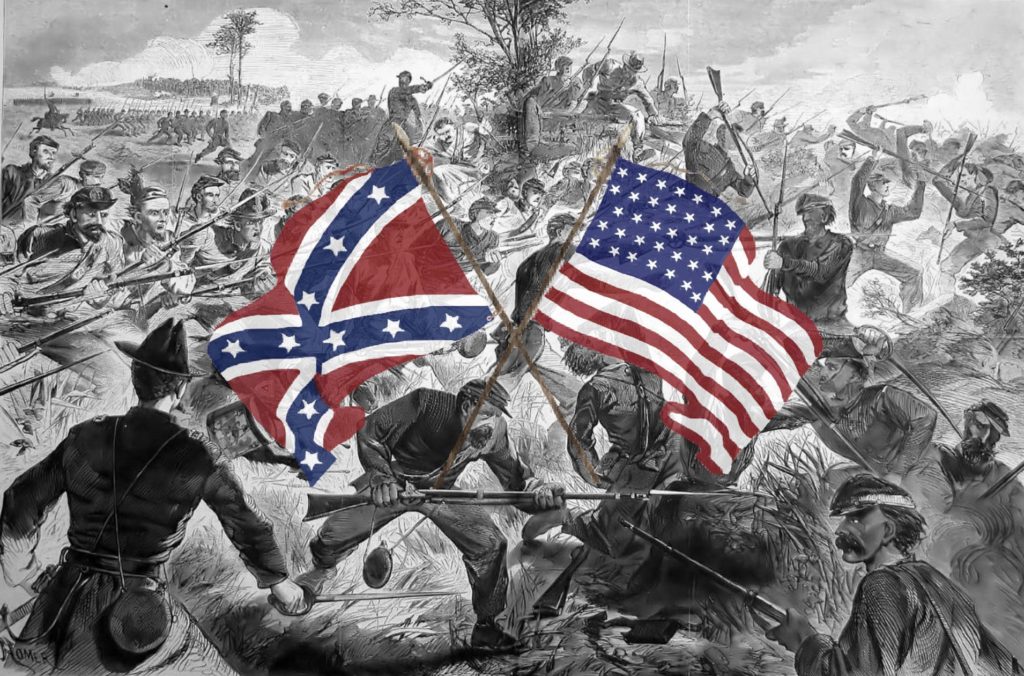Table of Contents
The Civil War in Fiction
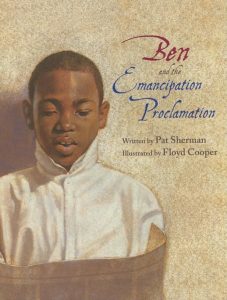 |
In Pat Sherman’s Ben and the Emancipation Proclamation (Eerdmans Books for Young Readers, 2009), Ben is a young slave boy in Charleston, SC, who has learned to read – though literacy is illegal for slaves. Imprisoned when the war breaks out, Ben uses his forbidden skill to read the newspaper account of the signing of the Emancipation Proclamation to his fellow prisoners. For ages 5-9. |
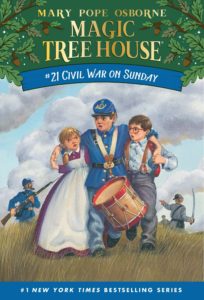 |
In Civil War on Sunday (Random House, 2000), one of Mary Pope Osborne’s immensely popular Magic Tree House series, Jack and Annie – attempting to help Morgan le Fay, librarian of Camelot – travel back in time to the Civil War, where they help Clara Barton, the “Angel of the Battlefield,” save wounded soldiers. For ages 6-9. |
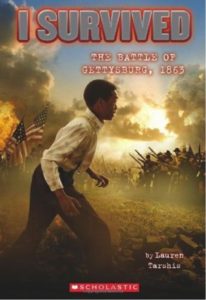 |
In Lauren Tarshis’s I Survived: Battle of Gettysburg, 1863 (Scholastic, 2013) – one of the I Survived series – eleven-year-old Thomas and his five-year-old sister, Birdie, have escaped from slavery and are headed north, following the North Star. The two are adopted by a regiment of Union soldiers – and end up in Pennsylvania at the bloody Battle of Gettysburg. For ages 7-10. |
| Check out the complete list of the I Survived books here and take a quiz to test your survival skills. | |
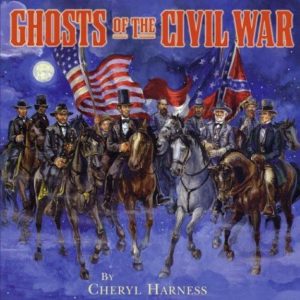 |
In Cheryl Harness’s Ghosts of the Civil War (Simon & Schuster, 2004), Lindsey – who has no interest in the Civil War – meets the ghost of young Willie Lincoln and ends up taking a personal tour of the war and its times. The book is packed with information – timelines, annotated maps, fact sidebars – and the dialogue is delivered in cartoon bubbles. A lot of interesting detail in 48 pages for ages 7-10. |
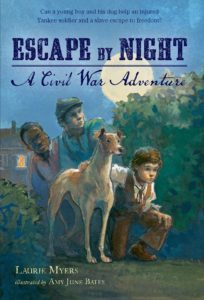 |
In Laurie Myers’s Escape by Night (Henry Holt and Company, 2011), 10-year-old Tommy and his sister Annie have been watching soldiers arrive in their Georgia town, where the local church has been turned into a hospital for the war-wounded. One of the soldiers drops his notebook and Tommy sends his dog to fetch it. He returns it to its owner – a soldier named Red – and a friendship begins. Soon, however, Tommy realizes that Red is actually a Union soldier – and he must make a decision based on his loyalties and his changing attitudes toward slavery and the war. For ages 7-10. |
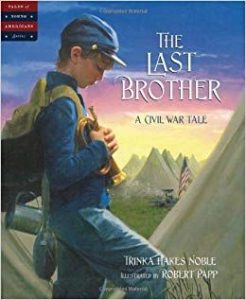 |
In Trinka Hakes Noble’s The Last Brother (Sleeping Bear Press, 2006), 11-year-old Gabe is a bugler for the Union troops at the Battle of Gettysburg, while his older brother Davy – his “last brother,” Gabe has already lost two to the war – is in the thick of the fray. Before the battle begins, Gabe meets Orlee, a young bugler from Mississippi, and the two boys discover that, despite their opposite allegiances, they have a lot in common. Suddenly Gabe has questions about loyalties to family, friends, and country – and when the order comes to sound the “Charge!,” he has to make a decision. For ages 7-11. |
| The Last Brother is a detailed teacher’s guide to accompany the book, with exercises and activities. Some are more appealing than others – “Soldier Math,” for example, includes such unexciting problems as “Gabe practiced the bugle for 3 hours each morning and 2 hours each evening. How many hours did he practice each week?” Other projects include making a Civil War diorama, writing an entry in Gabe’s journal, designing a medal for a bugler, and locating key sites from the Battle of Gettysburg on a map. | |
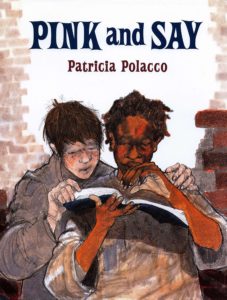 |
Patricia Polacco’s Pink and Say (Philomel, 1994) is based on the true story of a pair of teenaged soldiers. Pink, an African-American, finds Say left for dead on a Georgia battlefield, and carries him home to his mother, who nurses him back to health. Pink’s mother is killed by marauders, and the two boys – later captured – end up in Andersonville Prison, where Pink is hanged, but Say survives to tell their story. A powerful, but heart-wrenching, tale for ages 8 and up. |
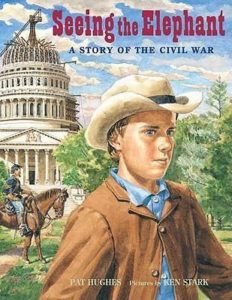 |
“Seeing the elephant” was 19th-century slang for a first experience of battle. In Pat Hughes’s Seeing the Elephant: A Story of the Civil War (Farrar, Straus, & Giroux, 2007), 10-year-old Izzie’s two older brothers are off to fight for the Union. Izzie wants desperately to go too – but when he meets a wounded rebel soldier at the hospital where his Aunt Bell works as a nurse, he learns that war is far more complicated than he had believed. For ages 8 and up. |
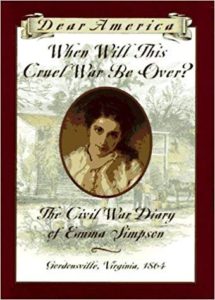 |
Barry Denenberg’s When Will This Cruel War Be Over? The Diary of Emma Simpson (Scholastic, 2011) in the Dear America series is the story in Emma’s words of life in Virginia during the days of the Civil War, dealing with hardship and scarcity, the absence of her father, the death of her brother. “I never realized how happy I was until this war besieged our land,” Emma writes. For ages 8-12. |
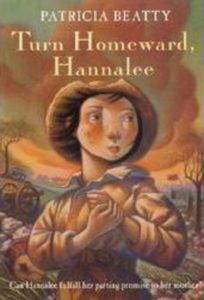 |
In Patricia Beatty’s Turn Homeward, Hannalee (HarperCollins, 1999), 12-year-old Hannalee is one of 2000 Georgia millworkers forcibly sent to work in the North after General Sherman passes through town and burns the mill. Hannalee is determined to find her younger brother and to return home to her mother. Based on true historical events. There’s a sequel, set in 1865: Be Ever Hopeful, Hannalee. For ages 8-12. |
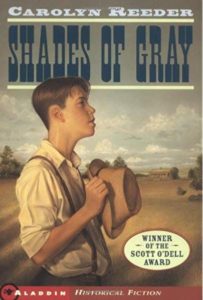 |
In Carolyn Reader’s award-winning Shades of Gray (Aladdin, 1999), 12-year-old Will has lost his entire family in the Civil War, and now is being sent to live on a farm with unknown relatives. There he meets his Uncle Jed, who has refused to fight for the Confederacy. Will considers him to be a coward and a traitor – until he gradually comes to see that there are many kinds of courage, For ages 8-12. |
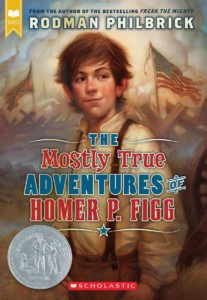 |
In Rodman Philbrick’s The Mostly True Adventures of Homer P. Figg (Scholastic, 2011), Homer’s wicked guardian, Uncle Squint, has sold his older brother, Harold, to the Union Army, to take the place of a rich man’s son. Homer, who has a talent for telling whoppers, sets out to rescue him, having adventures along the way with a host of colorful characters, among them a pair of repulsive slave catchers, a kindly Quaker, and the suspect Professor Fleabottom, owner of a medicine show called the Caravan of Miracles. Homer is accused of spying, but escapes in a hot-air balloon; finally he finds his brother and the pair end up fighting in the Battle of Gettysburg under the command of Joshua Lawrence Chamberlain. A great story for ages 9-12. |
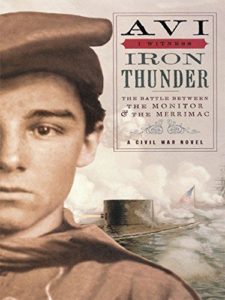 |
In Avi’s Iron Thunder (Disney-Hyperion, 2009), 13-year-old Tom takes a job in the Brooklyn, NY, ironworks after his father is killed fighting for the Union. There he becomes friends with inventor John Ericsson, who is building a remarkable ironclad ship, the Monitor, destined to battle the Confederate Merrimac. Tom’s association with Ericsson makes him a target for Confederate spies; to escape, he ends up living on board the boat – and sailing with her when she heads for her great sea battle. For ages 9-13. |
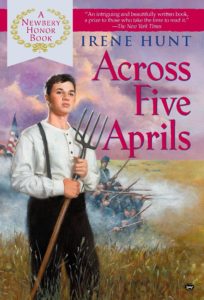 |
Irene Hunt’s Across Five Aprils (Berkley, 2002) is the story of young Jethro Creighton through the years – five Aprils – of the Civil War, as his brothers and teacher leave to fight for either the Union or the Confederacy. A good discussion book for ages 10 and up. |
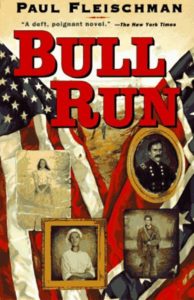 |
Paul Fleischman’s Bull Run (HarperCollins, 1995) is a fascinating account of the terrible Civil War battle, told from sixteen different points of view (black and white, male and female, Union and Confederate). Excellent for ages 10 and up. |
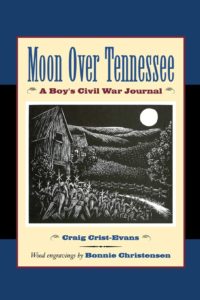 |
By Craig Crist-Evans, Moon Over Tennessee (Houghton Mifflin Harcourt, 2003), illustrated with wood engravings by Bonnie Christensen, is a free-verse “diary” of a 13-year-old farm boy from Tennessee who goes with his father when he joins the Confederate army, and stays with him until his father’s death at the Battle of Gettysburg. For ages 10 and up. |
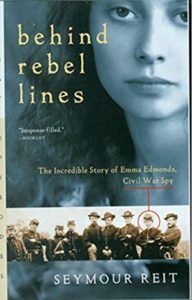 |
Seymour Reit’s Behind Rebel Lines (Houghton Mifflin Harcourt, 2001) is the incredible (true) story of Emma Edmonds who disguised herself as a man and joined the Union Army – and later became a spy, working behind enemy lines. A suspenseful read for ages 12 and up. |
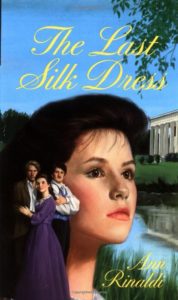 |
Ann Rinaldi’s The Last Silk Dress (Starfire, 1990), set in the Civil War, is a story of conflicting loyalties. Fourteen-year-old Susan does her best to help the Confederacy, by collecting silk dresses to make a reconnaissance balloon to spy on the enemy forces. Then she meets her scandalous brother Lucien – who has long been banished from the family – and her views of the war begin to change. For ages 12 and up. |
| Other Civil-War-era books by Ann Rinaldi include Leigh Anne’s Civil War (Houghton Mifflin Harcourt, 2011), My Vicksburg (Houghton Mifflin Harcourt, 2011), The Last Full Measure (Houghton Mifflin Harcourt, 2010), and The Girl in Blue (Scholastic, 2005). | |
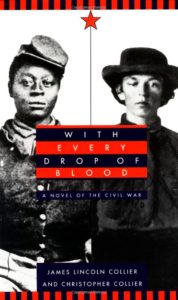 |
In James Collier’s With Every Drop of Blood (Laurel Leaf, 1996), 14-year-old Johnny – the book’s narrator – has promised his father (now dead of war wounds) that he’ll stay on the family farm in Virginia. Instead, he embarks on a dangerous mission to smuggle food into besieged Richmond, and is captured by black Union soldiers. One of these – Cush – is about Johnny’s age and eventually the boys develop a friendship. For ages 12 and up. |
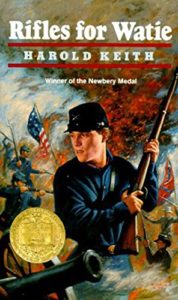 |
Harold Keith’s Rifles for Watie (HarperTeen, 1987), a Newbery Medal winner, is the story of sixteen-year-old Jeff Bussey who joins the Union Army in 1861 – and finds that war is far more than he bargained for. For ages 13 and up. |
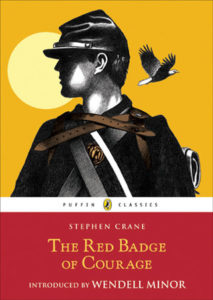 |
Stephen Crane’s The Red Badge of Courage (many editions). originally published in 1895 and now a classic, is the story of a young Civil War private who runs from the battlefield – and then, ashamed, hopes to be wounded, to acquire a “red badge of courage.” Reviews waffle between “brilliant” and “awful” – though it’s said to give a close-to-being-there description of what it was like to fight in the Civil War. For ages 13 and up. |
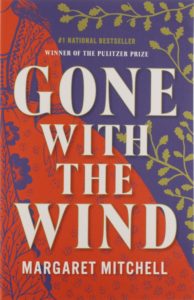 |
Margaret Mitchell’s romantic classic Gone with the Wind (Scribner, 2011) is the story of Scarlett O’Hara – beautiful, selfish, spoiled, and brave – raised in luxury on a plantation and then plunged into the horrors of the Civil War. For ages 13 and up. |
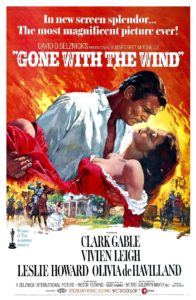 |
The 1939 movie version of Gone With the Wind, starring Vivien Leigh as Scarlett and Clark Gable as Rhett Butler, is rated PG.
Spectacular to view; just don’t depend on it for an accurate picture of slavery or the Ku Klux Klan. |
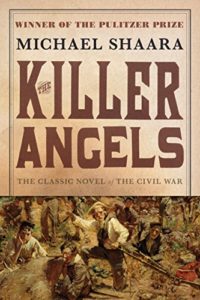 |
Michael Shaara’s Pultizer-Prize-winning The Killer Angels (Ballantine Books, 1996) is a brilliant historical novel, a dramatized account of the four days of the Battle of Gettysburg. A superb read for teens and adults. |
| From Carol Hurst’s Literature Site, The Civil War in Children’s Literature is an overview of recommended books with Civil War themes, with some extension suggestions. |
